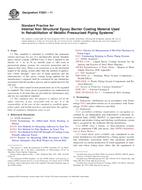1.1 This test method covers a procedure that accelerates the natural weathering rate of a solid material sample so that diagnostic weathering products can be produced, collected, and quantified. Soluble weathering products are mobilized by a fixed-volume aqueous leach that is performed, collected, and analyzed weekly. When conducted in accordance with the following protocol, this laboratory test method has accelerated metal-mine waste-rock weathering rates by at least an order of magnitude greater than observed field rates (1).
1.1.1 This test method is intended for use to meet kinetic testing regulatory requirements for mining waste and ores.
1.2 This test method is a modification of an accelerated weathering test method developed originally for mining wastes (2-4). However, it may have useful application wherever gaseous oxidation coupled with aqueous leaching are important mechanisms for contaminant mobility.
1.3 This test method calls for the weekly leaching of a 1000-g solid material sample, with water of a specified purity, and the collection and chemical characterization of the resulting leachate over a minimum period of 20 weeks.
1.4 As described, this test method may not be suitable for some materials containing plastics, polymers, or refined metals. These materials may be resistant to traditional particle size reduction methods.
1.5 Additionally, this test method has not been tested for applicability to organic substances and volatile matter.
1.6 This test method is not intended to provide leachates that are identical to the actual leachate produced from a solid material in the field or to produce leachates to be used as the sole basis of engineering design.
1.7 This test method is not intended to simulate site-specific leaching conditions. It has not been demonstrated to simulate actual disposal site leaching conditions.
1.8 This test method is intended to describe the procedure for performing the accelerated weathering of solid materials to generate leachates. It does not describe all types of sampling and analytical requirements that may be associated with its application.
1.9 The values stated in SI units are to be regarded as the standard. The values given in parentheses are for information only.
1.10 This standard does not purport to address all of the safety concerns, if any, associated with its use. It is the responsibility of the user of this standard to establish appropriate safety and health practices and determine the applicability of regulatory limitations prior to use.
Product Details
- Published:
- 01/01/2001
- Number of Pages:
- 13
- File Size:
- 1 file , 200 KB


